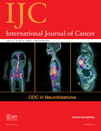Merkel cell carcinoma subgroups by Merkel cell polyomavirus DNA relative abundance and oncogene expression
Abstract
Merkel cell polyomavirus (MCPyV) was recently discovered in Merkel cell carcinoma (MCC), a clinically and pathologically heterogeneous malignancy of dermal neuroendocrine cells. To investigate this heterogeneity, we developed a tissue microarray (TMA) to characterize immunohistochemical staining of candidate tumor cell proteins and a quantitative PCR assay to detect MCPyV and measure viral loads. MCPyV was detected in 19 of 23 (74%) primary MCC tumors, but 8 of these had less than 1 viral copy per 300 cells. Viral abundance of 0.06–1.2 viral copies/cell was directly related to presence of retinoblastoma gene product (pRb) and terminal deoxyribonucleotidyl transferase (TdT) by immunohistochemical staining (p ≤ 0.003). Higher viral abundance tumors tended to be associated with less p53 expression, younger age at diagnosis and longer survival (p ≤ 0.08). These data suggest that MCC may arise through different oncogenic pathways, including ones independent of pRb and MCPyV.




